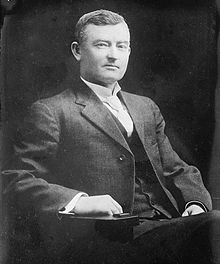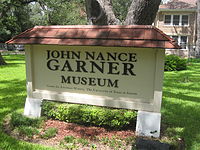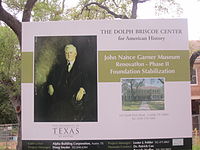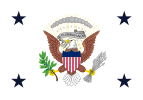- John Nance Garner
-
John Nance Garner 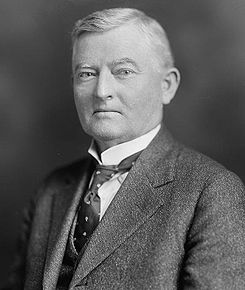
32nd Vice President of the United States In office
March 4, 1933 – January 20, 1941President Franklin D. Roosevelt Preceded by Charles Curtis Succeeded by Henry A. Wallace 44th Speaker of the United States House of Representatives In office
December 7, 1931 – March 4, 1933President Herbert Hoover Preceded by Nicholas Longworth Succeeded by Henry T. Rainey 8th Minority Leader of the United States House of Representatives In office
1929–1931Deputy William Allan Oldfield (whip) Preceded by Finis Garrett Succeeded by Bertrand Snell Member of the U.S. House of Representatives
from 's Texas' 15th districtIn office
March 4, 1903 – March 4, 1933Preceded by new district Succeeded by Milton H. West Personal details Born November 22, 1868
Detroit, Red River County
Texas, USA
USDied November 7, 1967 (aged 98)
Uvalde, Texas
USNationality American Political party Democratic Spouse(s) Mariette Rheiner Garner Children Tully Charles Garner Alma mater Vanderbilt University – dropped out Religion Methodist Signature 
John Nance Garner, IV (November 22, 1868 – November 7, 1967), was the 32nd Vice President of the United States (1933–1941) and the 44th Speaker of the United States House of Representatives (1931–33).
Contents
Early life and family
Garner was born near the village of Detroit in Red River County in East Texas, to John Nance Garner, III, and his wife, the former Sarah Jane Guest. Garner attended Vanderbilt University in Nashville, Tennessee, for one semester before dropping out and returning home. He was a member of the Pi Kappa Alpha fraternity. He eventually studied law, was admitted to the bar in 1890, and began practice in Uvalde, Uvalde County, Texas. He was County Judge of Uvalde County from 1893 to 1896. (Although the County Judge in Texas is now primarily the chief administrative officer of a County, comparable to the Mayor of a City, the office is a Judicial position and the County Judge sits in small civil cases, misdemeanor criminal cases, and probate cases.) In the 1893 campaign for Uvalde County Judge, his Democratic primary opponent was Mariette Rheiner, a rancher's daughter. He married her two years later, and they had one child, Tully Charles Garner.
Texas politics
Garner was a member of the Texas House of Representatives from 1898 to 1902. While in the Texas Legislature, a bill came up to select a state flower for Texas. Garner fervently supported the prickly pear cactus for the honor and earned the nickname "Cactus Jack" for his effort. The Bluebonnet eventually won out and was chosen as the state flower.
Garner was elected as a Democrat to the United States House of Representatives in 1902 from a newly created Congressional District covering tens of thousands of square miles of rural South Texas. He was elected from the District fourteen subsequent times, serving until 1933. His wife served as his private secretary during this period.
Garner's hard work and integrity made him a respected leader in the House, and he was chosen to serve as minority floor leader for the Democrats in 1929, and then as Speaker of the United States House of Representatives in 1931.
Garner was a supporter of the federal income tax but opposed most tariffs except for those on wool and mohair, important to his Texas base. He also believed in rural investment, bringing much needed dollars to farmers of the Brush Country region of South Texas.[1][unreliable source?]
Popular with his fellow House members in both parties, Garner held what he called his "board of education" during the era of prohibition, a gathering spot for lawmakers to drink alcohol, or as Garner called it, "strike a blow for liberty." The "board of education" was continued after prohibition had ended by future Democratic Speaker Sam Rayburn, a Tennessee native from Bonham, Texas.[1] According to the historian Patrick Cox of the University of Texas, prohibition became a major but almost forgotten issue in the 1932 campaign in which Franklin D. Roosevelt, with Garner as his running mate, defeated the Republican Hoover-Curtis ticket.[1]
Vice Presidency
In 1932, Garner ran for the Democratic Presidential nomination against Governor of New York Franklin Roosevelt. When it became evident that Roosevelt was the strongest of several candidates, although he had not yet received a majority of delegates (thanks to opposition figures and despite receiving most of the popular support), Garner cut a deal with Roosevelt, becoming his Vice-Presidential candidate. He was re-elected to the Seventy-third Congress on November 8, 1932, and on the same day was elected Vice President of the United States, making him the only man to serve as both Speaker of the House and President of the Senate on the same day (March 4, 1933). He was re-elected Vice President in 1936 and served in that office from March 4, 1933, to January 20, 1941. Garner once described the Vice-Presidency as being "not worth a bucket of warm piss."[2]
During Roosevelt's second term, Garner's previously warm relationship with the President quickly soured, as Garner disagreed sharply with him on a wide range of important issues. Garner supported federal intervention to break up the Flint Sit-Down Strike, supported a balanced federal budget, opposed packing the Supreme Court with additional judges, and opposed executive interference with the internal business of the Congress.
During 1938 and 1939, numerous Democratic party leaders urged Garner to run for President in 1940. Garner saw himself as the champion of the traditional Democratic Party establishment, which often clashed with supporters of Roosevelt's New Deal. The Gallup Poll showed that Garner was the favorite among Democratic voters, presuming that Roosevelt would defer to the longstanding two-term tradition and not run for a third term. Time magazine characterized him on April 15, 1940:
Cactus Jack is 71, sound in wind & limb, a hickory conservative who does not represent the Old South of magnolias, hoopskirts, pillared verandas, but the New South: moneymaking, industrial, hardboiled, still expanding too rapidly to brood over social problems. He stands for oil derricks, sheriffs who use airplanes, prairie skyscrapers, mechanized farms, $100 Stetson hats. Conservative John Garner appeals to many a conservative voter.[3]
Garner did not appeal to liberals, however. Union leader John L. Lewis testified before Congress that Garner was a "a labor-baiting, poker-playing, whiskey-drinking, evil old man."[4]
Roosevelt quietly made it known that he would seek a third term. Even though this decision made it highly unlikely that Garner would win the nomination, he stayed in the race anyway, because he opposed much of what the President stood for, and opposed the idea of anyone having a third term as President. Roosevelt easily won re-nomination at the Democratic National Convention on the first ballot and chose Henry A. Wallace to be his running mate, leaving Garner without an office.
Later life and legacy
Garner stepped down as Vice President in January 1941, ending a 46-year career in public life. He retired to his home in Uvalde for the last twenty-six years of his life, where he managed his extensive real estate holdings, spent time with his great-grandchildren, and fished. Throughout his retirement, he was consulted by active Democratic politicians and was especially close to Harry S. Truman.
On the morning of Garner's 95th birthday on November 22, 1963, President John F. Kennedy called from Fort Worth, to wish the former Vice President a happy birthday, just hours before his fateful trip to Dallas.
Garner died at the age of 98 years and 350 days, 15 days before his 99th birthday, making him the longest-living Vice President in United States history, a record which was previously held by Vice President Levi P. Morton. He is interred in Uvalde Cemetery.
Garner and Schuyler Colfax are the only two Vice Presidents to have been Speaker of the House of Representatives prior to becoming Vice President. As the Vice President is also the President of the Senate, this means that Garner and Colfax are the only people in history to have served as the presiding officer of both houses of Congress.
The popular Garner State Park, located 30 miles (48 km) north of Uvalde, bears his name, as does Garner Field just east of Uvalde. The women's dormitory at Southwest Texas Junior College in Uvalde bears Mrs. Garner's name.
See also
References
- ^ a b c Patrick Cox, University of Texas, "John Nance Garner", West Texas Historical Association joint meeting with the East Texas Historical Association at Fort Worth, February 26, 2010
- ^ Blumenthal, Sidney (June 28, 2007). "The imperial vice presidency". Salon.com. http://www.salon.com/opinion/blumenthal/2007/06/28/cheney/. Retrieved September 22, 2007.
- ^ see online
- ^ Time Aug 7, 1939
Sources
- John Nance Garner at the Biographical Directory of the United States Congress
- John Nance Garner at Find A Grave
- Champagne, Anthony. "John Nance Garner," in Raymond W Smock and Susan W Hammond, eds. Masters of the House: Congressional Leadership Over Two Centuries (1998) pp 144–80
- Timmons, Bascom N. Garner of Texas: A Personal History. 1948.
- Will, George. "In Cactus Jack's Footsteps". Jewish World Review Jan. 6, 2000.
External links
Political offices Preceded by
Charles CurtisVice President of the United States
March 4, 1933 – January 20, 1941Succeeded by
Henry A. WallacePreceded by
Nicholas LongworthSpeaker of the United States House of Representatives
December 7, 1931 – March 4, 1933Succeeded by
Henry T. RaineyPreceded by
Finis GarrettMinority Leader of the United States House of Representatives
March 4, 1929 – December 7, 1931Succeeded by
Bertrand SnellUnited States House of Representatives Preceded by
New districtMember of the U.S. House of Representatives
from Texas's 15th congressional district
March 4, 1903 – March 4, 1933Succeeded by
Milton H. WestParty political offices Preceded by
Joseph Taylor RobinsonDemocratic Party vice presidential candidate
1932, 1936Succeeded by
Henry A. WallacePreceded by
Finis GarrettHouse Democratic Leader
1929–1931Succeeded by
Henry T. RaineySpeakers of the United States House of Representatives Muhlenberg · Trumbull · Muhlenberg · Dayton · Sedgwick · Macon · Varnum · Clay · Cheves · Clay · Taylor · Barbour · Clay · Taylor · Stevenson · Bell · Polk · Hunter · White · Jones · Davis · Winthrop · Cobb · Boyd · Banks · Orr · Pennington · Grow · Colfax · Pomeroy · Blaine · Kerr · Randall · Keifer · Carlisle · Reed · Crisp · Reed · Henderson · Cannon · Clark · Gillett · Longworth · Garner · Rainey · Byrns · Bankhead · Rayburn · Martin · Rayburn · Martin · Rayburn · McCormack · Albert · O'Neill · Wright · Foley · Gingrich · Hastert · Pelosi · BoehnerMinority Leaders of the United States House of Representatives Democratic Party Leaders in the United States House of Representatives Democratic Party Chairpersons
of the DNCHallett · McLane · Smalley · Belmont · Schell · Hewitt · Barnum · Brice · Harrity · Jones · Taggart · Mack · McCombs · McCormick · Cummings · White · Hull · Shaver · Raskob · Farley · Flynn · Walker · Hannegan · McGrath · Boyle · McKinney · Mitchell · Butler · Jackson · Bailey · O'Brien · Harris · O'Brien · Westwood · Strauss · Curtis · White · Manatt · Kirk · Brown · Wilhelm · DeLee · Dodd/Fowler · Romer/Grossman · Rendell/Andrew · McAuliffe · Dean · Kaine · Wasserman Schultz
Presidential tickets Jackson/Calhoun · Jackson/Van Buren · Van Buren/R. M. Johnson · Polk/Dallas · Cass/Butler · Pierce/King · Buchanan/Breckinridge · Douglas/H. V. Johnson (Breckinridge/Lane, SD) · McClellan/Pendleton · Seymour/Blair · Greeley/Brown · Tilden/Hendricks · Hancock/English · Cleveland/Hendricks · Cleveland/Thurman · Cleveland/Stevenson I · W. J. Bryan/Sewall · W. J. Bryan/Stevenson I · Parker/H. G. Davis · W. J. Bryan/Kern · Wilson/Marshall · Cox/Roosevelt · J. W. Davis/C. W. Bryan · Smith/Robinson · Roosevelt/Garner · Roosevelt/Wallace · Roosevelt/Truman · Truman/Barkley · Stevenson II/Sparkman · Stevenson II/Kefauver · Kennedy/Johnson · Johnson/Humphrey · Humphrey/Muskie · McGovern/(Eagleton, Shriver) · Carter/Mondale · Mondale/Ferraro · Dukakis/Bentsen · Clinton/Gore · Gore/Lieberman · Kerry/Edwards · Obama/Biden
Parties by state
and territoryStateAlabama · Alaska · Arizona · Arkansas · California · Colorado · Connecticut · Delaware · Florida · Georgia · Hawaii · Idaho · Illinois · Indiana · Iowa · Kansas · Kentucky · Louisiana · Maine · Maryland · Massachusetts · Michigan · Minnesota · Mississippi · Missouri · Montana · Nebraska · Nevada · New Hampshire · New Jersey · New Mexico · New York · North Carolina · North Dakota · Ohio · Oklahoma · Oregon · Pennsylvania · Rhode Island · South Carolina · South Dakota · Tennessee · Texas · Utah · Vermont · Virginia · Washington · West Virginia · Wisconsin · Wyoming
TerritoryConventions
(List)1832 (Baltimore) · 1835 (Baltimore) · 1840 (Baltimore) · 1844 (Baltimore) · 1848 (Baltimore) · 1852 (Baltimore) · 1856 (Cincinnati) · 1860 (Baltimore) · 1864 (Chicago) · 1868 (New York) · 1872 (Baltimore) · 1876 (Saint Louis) · 1880 (Cincinnati) · 1884 (Chicago) · 1888 (Saint Louis) · 1892 (Chicago) · 1896 (Chicago) · 1900 (Kansas City) · 1904 (Saint Louis) · 1908 (Denver) · 1912 (Baltimore) · 1916 (Saint Louis) · 1920 (San Francisco) · 1924 (New York) · 1928 (Houston) · 1932 (Chicago) · 1936 (Philadelphia) · 1940 (Chicago) · 1944 (Chicago) · 1948 (Philadelphia) · 1952 (Chicago) · 1956 (Chicago) · 1960 (Los Angeles) · 1964 (Atlantic City) · 1968 (Chicago) · 1972 (Miami Beach) · 1976 (New York) · 1980 (New York) · 1984 (San Francisco) · 1988 (Atlanta) · 1992 (New York) · 1996 (Chicago) · 2000 (Los Angeles) · 2004 (Boston) · 2008 (Denver) · 2012 (Charlotte)
Affiliated
organizations21st Century Democrats · America Votes · Blue Dog Coalition · Center for American Progress · College Democrats of America · Democratic Congressional Campaign Committee · Democratic Governors Association · Democratic Leadership Council · Democratic Legislative Campaign Committee · Democratic Senatorial Campaign Committee · Democrats Abroad · National Conference of Democratic Mayors · National Federation of Democratic Women · National Stonewall Democrats · Progressive Democrats of America · Young Democrats of America · Young Democrats of America High School Caucus
Related articles History · Superdelegate
Cabinet of President Franklin D. Roosevelt (1933–1945) Vice President 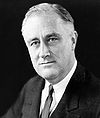
Secretary of State Secretary of War Secretary of the Treasury Attorney General Homer Stille Cummings (1933–1939) • Frank Murphy (1939–1940) • Robert H. Jackson (1940–1941) • Francis Biddle (1941–1945)Postmaster General Secretary of the Navy Claude A. Swanson (1933–1939) • Charles Edison (1940) • Frank Knox (1940–1944) • James Forrestal (1944–1945)Secretary of the Interior Secretary of the Agriculture Secretary of Commerce Daniel C. Roper (1933–1938) • Harry Hopkins (1939–1940) • Jesse H. Jones (1940–1945) • Henry A. Wallace (1945)Secretary of Labor United States presidential election, 1932 Democratic Party
ConventionNominee: Franklin D. Roosevelt
VP nominee: John Nance Garner
Candidates: John Nance Garner · Al Smith · James A. ReedRepublican Party
ConventionNominee: Herbert Hoover
VP nominee: Charles Curtis
Candidiates: John J. Blaine · Calvin Coolidge · Joseph Irwin France · Albert Ritchie · William H. Murray · James W. WadsworthThird party and independent candidates Communist Party USA Prohibition Party Nominee: William David UpshawSocialist Party of America Independents and other candidates: United States presidential election, 1936 Democratic Party
ConventionRepublican Party
ConventionNominee: Alf Landon
VP nominee: Frank Knox
Candidiates: William Borah · Stephen A. Day · Lester J. Dickinson · Warren Green · Frank Knox · Earl Warren · Frederick SteiwerThird party and independent candidates Prohibition Party Socialist Party of America Union Party Independents and other candidates: United States presidential election, 1940 Democratic Party
ConventionNominee: Franklin D. Roosevelt
VP nominee: Henry A. Wallace
Candidates: James Farley · John Nance Garner · Cordell Hull · Millard TydingsRepublican Party
ConventionNominee: Wendell Willkie
VP nominee: Charles L. McNary
Candidiates: Styles Bridges · Thomas Dewey · Frank Gannett · Arthur James · Robert Taft · Arthur H. VandenbergThird party and independent candidates Prohibition Party Socialist Party of America Independents and other candidates: Categories:- Franklin D. Roosevelt administration cabinet members
- 1868 births
- 1967 deaths
- American Methodists
- Democratic Party Vice Presidents of the United States
- Democratic Party (United States) vice presidential nominees
- Members of the Texas House of Representatives
- Members of the United States House of Representatives from Texas
- Minority Leaders of the United States House of Representatives
- People from Red River County, Texas
- People from Uvalde County, Texas
- Speakers of the United States House of Representatives
- Texas Democrats
- Texas state court judges
- United States presidential candidates, 1932
- United States presidential candidates, 1940
- United States vice-presidential candidates, 1932
- United States vice-presidential candidates, 1936
- Vice Presidents of the United States
Wikimedia Foundation. 2010.

